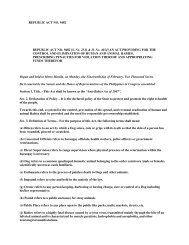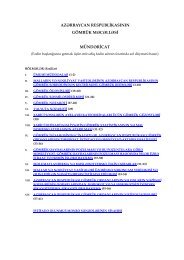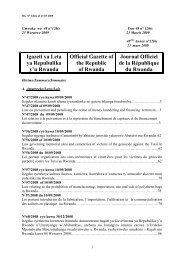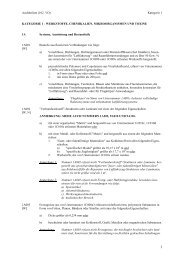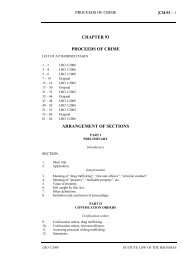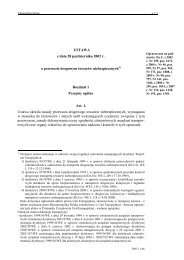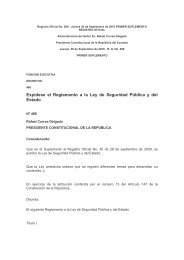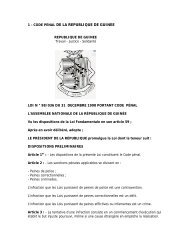The information revolution and verification - Andrew ... - VERTIC
The information revolution and verification - Andrew ... - VERTIC
The information revolution and verification - Andrew ... - VERTIC
You also want an ePaper? Increase the reach of your titles
YUMPU automatically turns print PDFs into web optimized ePapers that Google loves.
○ ○ ○ ○ ○ ○ ○ ○ ○ ○ ○ ○ ○ ○ ○ ○ ○ ○ ○ ○ ○ ○ ○ ○ ○ ○ ○ ○ ○ ○ ○ ○ ○ ○ ○ ○ ○ ○ ○ ○ ○ ○14<strong>The</strong> <strong>information</strong> <strong>revolution</strong><strong>and</strong> <strong>verification</strong><strong>Andrew</strong> RathmellTHERE IS LITTLE NEW about the problematic interplay between technology <strong>and</strong><strong>verification</strong>. Ever since the monitoring of arms control <strong>and</strong> disarmament agreementsbecame of interest the <strong>verification</strong> community has had to adapt to technologicalchange. On the one h<strong>and</strong>, regimes have had to be devised to cope with the latestweapon systems, <strong>and</strong>, on the other, modern technology has made possible new<strong>verification</strong> mechanisms.<strong>The</strong> current wave of innovation is no different. Developments in <strong>information</strong><strong>and</strong> communication technology (ICT) are driving transformations in the economic,political <strong>and</strong> military spheres. Powered by the forces of global capital, this trendis unstoppable, although its direction can to some extent be guided. <strong>The</strong> challengefor the <strong>verification</strong> community is to exploit the benefits of the <strong>information</strong> <strong>revolution</strong>,rather than allow it to create a whole new set of problems.This chapter provides an overview of the most important effects that the <strong>information</strong><strong>revolution</strong> has had on <strong>verification</strong>, <strong>and</strong> explores some of the dividends thatprogress in ICT could bring. It also considers a number of issues that will have tobe addressed if <strong>verification</strong> is to keep pace with technology.Advances in <strong>information</strong> technology (IT) <strong>and</strong> its convergence with sophisticatedcommunications systems are ushering in what has been labelled an ‘<strong>information</strong>age’ or ‘knowledge age’. It is argued that contemporary societies, led by the West,are being reshaped into ‘knowledge societies’. <strong>The</strong> concept of the <strong>information</strong> agedemonstrates the evolution from industrial-age manufacturing, through servicebasedproduction, to an <strong>information</strong> economy. <strong>The</strong> idea of a knowledge societyreflects the perception that <strong>information</strong> is no longer just a resource, like capital,labour <strong>and</strong> l<strong>and</strong>, but that it is increasingly the resource. 1<strong>The</strong>re is widespread scepticism about the extent, pace <strong>and</strong> consequences of this<strong>information</strong> <strong>revolution</strong>. Some observers argue that the Internet economy has failed
○ ○ ○ ○216Veririficaicationion Yearearboobook 2000to have a deep impact, even in the US. Others contend that the level of technologicalchange that was achieved in the first half of the twentieth century had more farreaching social, political <strong>and</strong> economic ramifications than the digital <strong>revolution</strong> ofrecent decades. 2This chapter remains agnostic about the extent <strong>and</strong> implications of the <strong>information</strong><strong>revolution</strong>. Nonetheless, it is indisputable that the digital <strong>revolution</strong> of the1980s <strong>and</strong> 1990s, along with associated commercial <strong>and</strong> political developments,has had a major impact on one aspect of international security that is of particularrelevance to <strong>verification</strong>: intelligence.Intelligence can be defined as ‘refined, analysed <strong>and</strong> assessed <strong>information</strong>’. It isimportant to stress that intelligence is about providing actionable data to decisionmakersto help them underst<strong>and</strong> a certain situation. Although covert sources <strong>and</strong>methods are often emphasised, these should not be at the core of the activity—they are tools that may add value to more openly collected documentation.Intelligence is at the heart of <strong>verification</strong>. Confidence- <strong>and</strong> security-buildingmeasures (CSBMs) are about enhancing transparency between potential adversaries,<strong>and</strong> arms control regimes are reliant on mutually acceptable <strong>and</strong> reliable compliancemechanisms, which are underpinned by trusted data. In the past, certain organisations,such as the International Atomic Energy Agency (IAEA) <strong>and</strong> the UnitedNations (UN), have shied away from the concept. But, today, they are increasinglycoming to accept that intelligence is central to their success <strong>and</strong> credibility.<strong>The</strong> <strong>information</strong> <strong>revolution</strong>, which is defined to include associated commercial<strong>and</strong> political changes, has an impact on intelligence in two broad areas. First, thedigitisation of data, along with increases in processing power, communicationb<strong>and</strong>width, <strong>and</strong> the production of sophisticated software, has made it possible tofilter, collate, store, retrieve, manipulate <strong>and</strong> disseminate <strong>information</strong> more effectively<strong>and</strong> faster than ever before.<strong>The</strong>se advances were summed up in 1995 by the US Central Intelligence Agency(CIA)’s then Deputy Director for Intelligence, John Gannon: 3. . . in the mid-1980s, the analyst communicated within CIA by pneumatictube; thous<strong>and</strong>s of separate, unrelated files were maintained at Headquarters;the mainframe <strong>and</strong> ‘dumb’ terminals were the ‘latest’ in technology; a megabytewas a lot of <strong>information</strong>; <strong>and</strong> most analysts saw computer expertise as a specialityin others’ h<strong>and</strong>s. In 2006 every analyst will be adept in the use of his/her own
○ ○ ○ ○<strong>The</strong> <strong>information</strong> <strong>revolution</strong> <strong>and</strong> <strong>verification</strong>217interactive terminal combining telephone, computer, <strong>and</strong> television; worldnetwill provide instant communications throughout the . . . [intelligence community]<strong>and</strong> consumer world; encryption will be unbreakable <strong>and</strong> fast; all <strong>information</strong>will be digitized; <strong>and</strong> a terabyte will be the norm for storage <strong>and</strong> retrievalof <strong>information</strong>.Second, the combination of new technologies (like the Internet), the commercialisationof previously classified technology (including very high-resolution satelliteimagery) <strong>and</strong> political change (such as the proliferation of news outlets in theformer Soviet Union) has led to an exponential increase in the amount of dataavailable from ‘open sources’. Institutions like the media <strong>and</strong> academia have alwaysbeen used by defence <strong>and</strong> foreign affairs intelligence agencies. However, the divisionbetween ‘white’ (open) <strong>and</strong> ‘black’ (closed, proprietary or classified) <strong>information</strong>was previously seen by the Western intelligence community as approximately an80:20 split. This ratio may now be 90:6:4 between ‘white’, ‘black’, <strong>and</strong> ‘grey’ <strong>information</strong>.4 <strong>The</strong>re is no doubt that vital added value is provided by ‘black’ sources,such as the UK–US Signals Intelligence (SIGINT) network, the Secret IntelligenceService, or the Human Intelligence assets of the CIA. Nonetheless, it is remarkablehow many of the intelligence requirements of most government departments canbe filled in whole, or in part, by open sources.Implications for <strong>verification</strong><strong>The</strong> implications of these developments for <strong>verification</strong> can usefully be discussedin the context of the traditional intelligence process, as used by most defence <strong>and</strong>national intelligence organisations. This process is based on a model for the developmentof intelligence or actionable knowledge, which starts with the structuredidentification of a consumer’s needs, recognition of <strong>information</strong> gaps <strong>and</strong> theformulation of a collection plan. <strong>The</strong> documentation is then analysed before it isdistributed to the consumer, providing the opportunity for further refinement ofthe <strong>information</strong> requirements.<strong>The</strong> process is often constructed as a cycle, involving the following steps:• planning <strong>and</strong> direction;• collection;• processing;• production <strong>and</strong> analysis;
○ ○ ○ ○218Veririficaicationion Yearearboobook 2000• assessment; <strong>and</strong>• dissemination.For now, it is helpful to focus on the effect that the <strong>information</strong> <strong>revolution</strong> has hadon the second, third, fourth <strong>and</strong> sixth phases of the cycle. Planning <strong>and</strong> directionhave been less affected by the <strong>information</strong> <strong>revolution</strong> so they will not be discussedin this chapter. And assessment remains at root a cognitive activity that is leastaffected by technological change.Collection<strong>The</strong> most obvious impact of the <strong>information</strong> <strong>revolution</strong> is on the collection ofdata for <strong>verification</strong> of arms control <strong>and</strong> disarmament regimes <strong>and</strong> export controls,as well as for use as CSBMs. Open sources—available commercially or sometimesat no cost—now provide much of the <strong>information</strong> that is needed to monitor boththe intentions <strong>and</strong> capabilities of states <strong>and</strong> sub-state groups that are either partyto a regime or are of concern to the international community. 5A proliferation of news sources <strong>and</strong> electronic discussion channels gives accessto large amounts of data on the politics, policies <strong>and</strong> deliberations of all but themost closed regimes <strong>and</strong> tightly centralised sub-state bodies. <strong>The</strong> interpretation of<strong>information</strong> on the intentions <strong>and</strong> world views of governments <strong>and</strong> other organisationsremains as difficult an analytical task as ever, although the open source <strong>revolution</strong>has at least provided the mass of documentation for analysts to work on. Itis important, of course, not to focus exclusively on the ‘new’ sources <strong>and</strong> channelsenabled by ICT. A lot of this data will be available from ‘traditional’ sources, suchas scholars, journalists, activists <strong>and</strong> business travellers. However, the communications<strong>revolution</strong>, the political opening up of much of the world <strong>and</strong> economicglobalisation have combined to increase the amount <strong>and</strong> quality of <strong>information</strong>that ‘traditional’ human sources can provide.Meanwhile, very high-resolution commercial satellite imagery (CSI) can be usedto monitor physical observables, like troop deployments, border violations <strong>and</strong>the construction of industrial facilities needed for production of weapons of massdestruction (WMD). <strong>The</strong> availability of CSI also results from technological change(the miniaturisation of satellites <strong>and</strong> sensors, improvements <strong>and</strong> cost reductionsin interpretation software, <strong>and</strong> better dissemination channels) <strong>and</strong> geopolitical<strong>and</strong> economic developments (the commercialisation of the Russian militaryindustrialcomplex <strong>and</strong> US government support for the marketing of its surveillance
○ ○ ○ ○<strong>The</strong> <strong>information</strong> <strong>revolution</strong> <strong>and</strong> <strong>verification</strong>219technologies). <strong>The</strong> outcome is that anybody with the necessary financial <strong>and</strong> organisationalresources can obtain imagery intelligence which approaches the qualityenjoyed by the superpowers in the 1970s. 6Information from commercial databases <strong>and</strong> specialist news services can beused to assess shipping movements <strong>and</strong> trade flows in regard to export controls orsanctions monitoring. Similar sources can be used to examine the activities ofpotential front companies <strong>and</strong> efforts to violate sanction regimes.At the same time, tracking the movements of individuals is becoming mucheasier. An increasing number of everyday tasks leave ‘digital footprints’ that arebeing exploited by commercial marketers <strong>and</strong> intelligence organisations. Effortsto ‘modernise’ government—which most advanced countries are engaged in—will have the effect (notwithst<strong>and</strong>ing data protection legislation) of giving intelligenceorganisations far more comprehensive pictures of the activities of citizenswithout recourse to cl<strong>and</strong>estine methods, such as physical or electronic surveillance.This has dramatic ramifications for the monitoring of people <strong>and</strong> of small groupsthat are of concern, for instance, in relation to arms proliferation.Processing, production <strong>and</strong> analysisAnalysis is at the root of the intelligence process. It is the activity most vulnerableto human error <strong>and</strong> least subject to technological ‘fixes’. <strong>The</strong> majority of intelligence‘failures’ are due to the foundering either of analysis or of underst<strong>and</strong>ing by decisionmakers,rather than to a breakdown in collection. 7 For any organisation engagedin processing <strong>and</strong> analysing data for <strong>verification</strong>, it is ultimately the quality <strong>and</strong>mindset of its analysts, combined with the analyst–consumer interface, that determinesuccess or failure.Nonetheless, the <strong>information</strong> <strong>revolution</strong> is having a significant impact on thispart of the intelligence process. For the purposes of this chapter, the most importantconsequence is the convergence of cheap <strong>and</strong> massive processing power withadvanced software, enabling huge volumes of data to be filtered, collated, mined<strong>and</strong> interpreted. <strong>The</strong> point is not to replace human analysts, but to assist themwith speedily explicating large amounts of <strong>information</strong> in order to extract patternsof activity that are of interest to decision-makers.This capability is advancing rapidly in the commercial world. Retail businesses,including supermarkets, have invested heavily in ‘data warehouses’ that store gigabytesof customer <strong>information</strong>. This is analysed by data mining technologies, which
○ ○ ○ ○220Veririficaicationion Yearearboobook 2000identify, for instance, fraudulent credit card use or food purchasing trends. Similartechnologies are being developed <strong>and</strong> applied by law enforcement agencies toprofile criminal behaviour. And part of the ‘joined-up’ system of government incountries like the UK is the effort to combine data sets on citizens—held bygovernment agencies—so that individual behaviour can be tracked <strong>and</strong>monitored. <strong>The</strong> objective is to provide better services for people <strong>and</strong> to preventcriminal actions.Developments in processing <strong>and</strong> analytical technologies are at least as importantfor <strong>verification</strong> as changes in open sources. Intelligent technologies allow the massof data provided by the open source <strong>revolution</strong> to be exploited effectively. Withoutautomated instruments, human analysts would be unable to filter, collate, store,mine <strong>and</strong> analyse this deluge of <strong>information</strong>. Furthermore, the production ofadvanced software tools makes analytical capabilities much more widely available.Whereas in the recent past it was only specialist public sector organisations, suchas the US National Security Agency, the UK Government Communications Headquarters<strong>and</strong> the Australian Defence Signals Directorate that had access to thesetechnologies, they are now routinely employed by small- <strong>and</strong> medium-sizedenterprises <strong>and</strong> local law enforcement agencies. Given the rate <strong>and</strong> pace of changein IT, the effectiveness <strong>and</strong> ease of use of such tools are likely to increase rapidly.DisseminationPresentation <strong>and</strong> dissemination are an often overlooked part of the intelligenceprocess. However, Western agencies have had to pay more attention to these issues.Intelligence staff at the North Atlantic Treaty Organization (NATO), for instance,often complain that their political decision-makers act on Cable News Network(CNN)’s unanalysed <strong>and</strong> hastily distributed data, rather than waiting for more consideredassessments from the formal intelligence process.To facilitate the speedy dissemination of well-presented intelligence products,the US intelligence community has responded by taking the lead in exploitingnew technologies, such as the Internet Protocol, Hyper Text Mark-up Language(HTML) <strong>and</strong> video conferencing. 8 <strong>The</strong> aim is to get analysed work to consumersfaster, <strong>and</strong> to enable consumers to interact with analysts <strong>and</strong> to arrive jointly atconclusions systematically, supported by an audited reasoning process. In addition,new technologies are being used to display data in a range of formats, text <strong>and</strong>images, that facilitate underst<strong>and</strong>ing <strong>and</strong> new ways of considering problems.
○ ○ ○ ○<strong>The</strong> <strong>information</strong> <strong>revolution</strong> <strong>and</strong> <strong>verification</strong>221While these technologies <strong>and</strong> approaches should make established state intelligenceorganisations more effective, the point is that they involve commercial offthe-shelfsystems. Indeed, many of the tools <strong>and</strong> techniques now being employedhave their origins in the entertainment industry or the financial sector, <strong>and</strong>, as aresult, are available to everyone. Some non-governmental groups, including political<strong>and</strong> environmental activists, have, in fact, made more effective use of communication<strong>and</strong> dissemination technologies than have government organisations. 9 This hasa significant effect on <strong>verification</strong> by empowering a range of actors, such as themedia, activists, <strong>and</strong> inter-governmental bodies <strong>and</strong> non-governmental organisations(NGOs), <strong>and</strong> by allowing them to construct robust <strong>and</strong> responsive regional<strong>and</strong> global <strong>information</strong> networks.Strategic implications<strong>The</strong> <strong>information</strong> <strong>revolution</strong> is having major ramifications on the sourcing, processing<strong>and</strong> dissemination of intelligence for those bodies undertaking monitoring<strong>and</strong> <strong>verification</strong>. For major governments with established intelligence bureaucracies,one can conclude that these trends will make <strong>verification</strong> easier. 10 However, the<strong>information</strong> <strong>revolution</strong> has some more interesting strategic implications that willaffect <strong>verification</strong>. <strong>The</strong> most significant of these are the effects on the <strong>information</strong>power differential <strong>and</strong> on the role of third parties.Information power has been broadly described as the sum of a country’s resourcesthat it can use to mould the global <strong>information</strong> environment, just as militarypower shapes the physical space. Some strategists argue that the <strong>information</strong> ageplays to the strengths of the US <strong>and</strong> that the country will have a global advantagein terms of ‘hard’ military <strong>and</strong> ‘soft’ <strong>information</strong> power. 11 Similarly, in specificregions, states that have the appropriate social, educational, political, <strong>and</strong> technologicalfoundations are likely to be better placed to exploit the <strong>information</strong> <strong>revolution</strong>,<strong>and</strong> thereby strengthen their <strong>information</strong> dominance over rivals. In the MiddleEast, for instance, this may apply to Israel, which has the societal infrastructure toexploit IT, <strong>and</strong>, therefore, to enhance its <strong>information</strong> edge over its Arab neighbours.This may well be one trend, but there is a countervailing paradigm of perhapsgreater significance. <strong>The</strong> rise of open sources <strong>and</strong> the diffusion through globalisedcommercial channels of ICT for gathering, analysing, <strong>and</strong> disseminating intelligencehave put powerful intelligence capabilities into the h<strong>and</strong>s of even NGOs <strong>and</strong> technologicallybackward <strong>and</strong> impoverished countries. This will go a long way towards
○ ○ ○ ○222Veririficaicationion Yearearboobook 2000countering the <strong>information</strong> imbalances between parties to CSBMs or arms controltreaties, <strong>and</strong> make it much easier for all sides to an agreement to gather, analyse<strong>and</strong> share data equitably.<strong>The</strong>re could be three specific outcomes to this trend. First, all parties to anaccord can have access to the intelligence capabilities that were previously monopolisedby the superpowers or regional hegemons. This is likely to have an impacton the willingness of states to enter into agreements <strong>and</strong> the structure of the <strong>verification</strong>regime that is put in place.Second, the increased role of open sources of <strong>information</strong> <strong>and</strong> commerciallyavailable processing tools should make it easier for countries to share data. Nationalintelligence agencies that are reliant on their own sources <strong>and</strong> methods will alwaysbe reluctant to share documentation <strong>and</strong> intelligence. But CSBMs <strong>and</strong> arms controlregimes rely on transparency <strong>and</strong> <strong>information</strong> sharing; squaring this circle hasbeen a vital but tricky part of past CSBM <strong>and</strong> arms control processes. <strong>The</strong> <strong>information</strong><strong>revolution</strong> eases this problem. For instance, an increasingly popular concept isthat of regional conflict prevention, involving crisis monitoring centres. In themid-1990s, the Association of South-East Asian Nations (ASEAN) Regional Forummooted the concept <strong>and</strong> it also emerged during the Middle East arms control <strong>and</strong>regional security talks. 12But this concept has been hindered by credibility problems. Quite simply, statesthat do not yet trust one another are loath to allow such a facility to have accessto sensitive sources <strong>and</strong> methods. Increasingly, however, centres could relyexclusively on open sources, assisted by advanced processing <strong>and</strong> knowledgemanagement techniques. <strong>The</strong>y would be able to produce unclassified intelligenceon military deployments, doctrines <strong>and</strong> budgets, for example, that would underpinglobal or regional CSBMs <strong>and</strong> arms control regimes. As important, staff secondedto such centres would have the opportunity both to work with erstwhile enemiesin a relatively open atmosphere <strong>and</strong> to achieve a common underst<strong>and</strong>ing of theiroperational environment.Third, <strong>and</strong> perhaps most significantly, the <strong>information</strong> <strong>revolution</strong> could transformthe role of outside parties in verifying the implementation of peace accords,<strong>and</strong>, in some respects, arms control regimes. Generally, peace agreements havebeen verified by states parties, often with the help of a small number of outsidecountries, notably the US. This was the case, for instance, with the Israel–EgyptSeparation of Forces Agreement of January 1974. With global arms control measures,
○ ○ ○ ○<strong>The</strong> <strong>information</strong> <strong>revolution</strong> <strong>and</strong> <strong>verification</strong>223such as the 1968 Nuclear Non-Proliferation Treaty(NPT), it has also been certainleading states that have sometimes supported <strong>verification</strong> with national intelligence.Overwhelmingly, the international community has relied on the US—the onlycountry with the global monitoring resources needed for the job.<strong>The</strong> <strong>information</strong> <strong>revolution</strong> changes this situation. While the American intelligencecommunity will continue to have capabilities unmatched by other statesor by the commercial sector, an increasing number of <strong>verification</strong> tasks can becarried out using open sources <strong>and</strong> methods. Consequently, the capability to assessagreements is proliferating along with the technology. Since 1995, the WesternEuropean Union (EU) has operated a satellite centre that primarily uses CSI toassist with monitoring the 1990 Conventional Armed Forces in Europe (CFE) Treaty.<strong>The</strong> IAEA is beginning to fuse a range of open sources to enable it to detect proactivelyviolations of the NPT. Research centres are showing an increasing capability totrack weapons of mass destruction (WMD) developments across the world, <strong>and</strong>NGOs, such as the transnational Forum on Early Warning <strong>and</strong> Response, are exploitingopen sources <strong>and</strong> communication networks to help predict humanitarian crises.And companies like the US-based Open Source Solutions <strong>and</strong> Stratfor offer aroutine political <strong>and</strong> military monitoring service.<strong>The</strong> result is that future arms control <strong>and</strong> CSBM regimes will be able to call on amuch wider range of outside parties to assist with <strong>verification</strong>. <strong>The</strong> US will stillhave a role to play, but agencies like the IAEA <strong>and</strong> the Organization for the Prohibitionof Chemical Weapons (OPCW) will be able to do much more themselves. Inaddition, other state actors (such as the EU), non-state actors (like research institutes<strong>and</strong> activist networks), companies <strong>and</strong> media outlets will be able to contributeto <strong>verification</strong>.Challenges<strong>The</strong> <strong>information</strong> <strong>revolution</strong> not only makes <strong>verification</strong> easier, but, in certainrespects, it poses new problems. Three of the most significant are:• encryption;• technology diffusion; <strong>and</strong>• electronic attack capabilities.<strong>The</strong> debate over encryption policy is a well-worn one in Western societies. Towardsthe end of 1999 the US government seemed to have acknowledged that it was
○ ○ ○ ○224Veririficaicationion Yearearboobook 2000fighting a losing battle in seeking to control the export of encryption software. Itsmore liberal approach parallels that of other states. 13 Nonetheless Western intelligenceagencies are still grappling with the likely loss of one of their most usefulsources: signals intelligence from intercepted communications.Encryption poses a similar problem for CSBMs <strong>and</strong> arms control <strong>verification</strong>.Western intelligence agencies that help to monitor such regimes rely heavily onSIGINT, tapping into global civilian, military <strong>and</strong> government voice <strong>and</strong> data links.Although they have the computing power to crack most encryption codes in time,the widespread availability of encryption to governments, citizens <strong>and</strong> sub-stategroups will make their job much harder, more time consuming <strong>and</strong> more resourceintensive. <strong>The</strong> proliferation of strong encryption thus makes it harder for nationalsignals intelligence agencies to assist with <strong>verification</strong>.<strong>The</strong> problem presented by encryption is a subset of a wider issue raised by thediffusion of ICT in the global market. Through the so-called Revolution in MilitaryAffairs, developments in ICT are enabling the US <strong>and</strong> some of its allies to becomemore powerful in conventional military terms. No other state will be able to matchthe mobile <strong>and</strong> lethal force that the US will deploy under its Joint Vision 2010blueprint for network-centric warfare. 14 But states <strong>and</strong> sub-state groups will beable to exploit niche technologies like WMD, allowing them to pack a powerfulpunch. Another concern is that small states <strong>and</strong> sub-state groups may exploitfreely available commercial <strong>information</strong> <strong>and</strong> communication technologies in orderto utilise limited resources against their larger opponents.<strong>The</strong>se technologies range from mobile, secure, satellite communications, throughintelligence gathering <strong>and</strong> mission planning tools, to precision-guided munitions.If networked, media-savvy groups or state organisations take advantage of thiscombination of technologies they could pose serious military threats to status quopowers. 15 Russia has faced a precursor to this problem with the Chechen rebels,<strong>and</strong> the US with Osama bin Laden. In <strong>verification</strong> terms, this raises difficultquestions about the nature of dual-use technologies <strong>and</strong> the convergence of military<strong>and</strong> civilian technologies <strong>and</strong> applications.<strong>The</strong>se difficulties are brought into sharp focus in the emerging debate over<strong>information</strong> warfare (IW). This is a broad concept, but a particularly problematicaspect is that of electronic attack or, more specifically, Computer Network Attack(CNA). <strong>The</strong> latter involves the use of computers to launch a logical strike on terminalsvia digital networks <strong>and</strong> telecommunication links. Assaults may result in the
○ ○ ○ ○<strong>The</strong> <strong>information</strong> <strong>revolution</strong> <strong>and</strong> <strong>verification</strong>225denial of services or the compromising of data integrity <strong>and</strong> confidentiality.Although long used as a tool of espionage <strong>and</strong> to some extent integrated intobattlefield electronic warfare, CNA is becoming of greater concern to countries<strong>and</strong> businesses that are ever more reliant on networked <strong>information</strong> systems <strong>and</strong>the Internet. A number of states have followed the US lead in identifying logicalthreats to their increasingly interconnected <strong>and</strong> interdependent Critical NationalInfrastructure (CNI) as major security concerns. 16<strong>The</strong>se fears have led to a debate over how best to characterise <strong>and</strong> deal withthe danger. <strong>The</strong> approach currently favoured by the US <strong>and</strong> its allies, which areinvesting in offensive IW techniques, is to treat it as a criminal or terrorist problem.<strong>The</strong>y are pushing for enhanced international co-operation in order to put inplace the legal, technical <strong>and</strong> policing measures necessary to ensure that all countrieswork together to protect their CNI <strong>and</strong> the global <strong>information</strong> infrastructure.An opposite perspective has emerged from states that feel threatened by thepossibility of offensive IW by the West. Russia has championed this approach<strong>and</strong> has proposed that the UN treats IW as a military issue in the General Assembly’sFirst Committee <strong>and</strong> discusses outlawing it. This involves viewing CNA as militarytechnology, <strong>and</strong> thus devising laws of armed conflict <strong>and</strong>, possibly, arms controlmeasures to restrict its proliferation <strong>and</strong> use.<strong>The</strong>re is growing pressure from within Western militaries to exploit their advantagesin this field. 17 This is likely to energise other members of the internationalcommunity to push for controls <strong>and</strong> to consider ways of limiting this new capability.Paradoxically, the problem is that any conceivable regime to restrict the use orpossession of IW poses tremendous challenges for <strong>verification</strong>. <strong>The</strong> tools <strong>and</strong>skills needed to conduct CNA are not only inherently dual-use, but they are alsovirtually impossible to monitor in a globalised, digital economy.Conclusion<strong>The</strong> <strong>information</strong> <strong>revolution</strong> should be a boon to <strong>verification</strong>. At heart, <strong>verification</strong>is about transparency <strong>and</strong> <strong>information</strong> sharing, which are both facilitated by progressin ICT. <strong>The</strong> latter gives advanced governments far greater capabilities to track<strong>and</strong> assess national <strong>and</strong> international developments. Meanwhile, the proliferationof these technologies diffuses monitoring capabilities widely across the internationalsystem. <strong>The</strong> environment in which today’s arms control <strong>and</strong> CSBM agreementswere forged was characterised by the uneven distribution <strong>and</strong> concentration of
○ ○ ○ ○226Veririficaicationion Yearearboobook 2000data in key states. In the <strong>information</strong> age, data resources will be much more broadlydispersed. Instead of relying on a h<strong>and</strong>ful of great powers, arms control <strong>and</strong> disarmamentregimes can be checked by a network of official <strong>and</strong> unofficial actors withextensive collection, analytical <strong>and</strong> distribution capabilities.This will have a significant impact on the identity <strong>and</strong> role of third parties,<strong>and</strong> on proposals for regional or global monitoring <strong>and</strong> <strong>information</strong>-sharingmechanisms. If the capability to check agreements is widespread <strong>and</strong> can largelyrely on open sources <strong>and</strong> methods, then the dynamics of arms control regimes willchange. International agencies, such as the IAEA <strong>and</strong> the OPCW, will gain in power<strong>and</strong> autonomy. As multinational organisations gradually lose their fear of ‘intelligence’<strong>and</strong> develop in-house intelligence structures, they will be able to exploitthe <strong>information</strong> <strong>revolution</strong> to collect, process <strong>and</strong> analyse vast amounts of opensource data on potential non-compliance. This will allow these institutions toverify compliance much more effectively, <strong>and</strong> will make them less reliant on intelligencefrom national technical means, which can be politically difficult to use. Atthe same time, private interests, like media organisations, research centres <strong>and</strong>NGOs, will play a greater role. Even small <strong>and</strong> technologically backward states willbe able to contribute to <strong>verification</strong>, rather than relying exclusively on allies, suchas the US.But technological developments will also pose challenges for existing <strong>and</strong> future<strong>verification</strong> regimes. Encryption will make the work of intelligence agencies harder,<strong>and</strong> the diffusion of niche dual-use technologies that can be exploited asymmetricallyby small groups <strong>and</strong> weak states raises complex monitoring issues. <strong>The</strong> latter isparticularly evident in relation to IW, which presents both a conceptual <strong>and</strong> animplementation problem for the <strong>verification</strong> community. Conceptually, decisionsneed to be made about whether to treat this new military capability as an armscontrol or criminal matter. In terms of implementation, if it is seen as a questionof military technology, then there will be tremendous problems in devising a monitoringregime to check development or the use of illicit capabilities.Technology poses the same dilemma it always has for <strong>verification</strong>: how to harnessthe benefits while minimising the downsides. A particular problem with the contemporary‘technology rush’ is that societal concepts <strong>and</strong> institutions tend to fall behindthe emergence of new technology. This lag is likely to be especially large in thecontext of the international community, which rarely acts quickly in any case.As technology moves further ahead of international policy-makers, it will probably
○ ○ ○ ○ ○ ○ ○ ○ ○ ○ ○ ○ ○ ○ ○ ○ ○ ○ ○ ○ ○ ○ ○ ○ ○ ○ ○ ○ ○ ○ ○ ○ ○ ○ ○ ○ ○ ○ ○ ○ ○ ○○ ○ ○ ○<strong>The</strong> <strong>information</strong> <strong>revolution</strong> <strong>and</strong> <strong>verification</strong>227take some time for the dividends to be harnessed. Meanwhile the downsides willbe left to worsen.Dr <strong>Andrew</strong> Rathmell is Executive Director of the International Centre for Security Analysis<strong>and</strong> Senior Lecturer in the Department of War Studies, King’s College London, UK. Heis editor of the Gulf States Newsletter, a specialist correspondent for Jane’s IntelligenceReview, <strong>and</strong> a regular contributor to the media.
○ ○ ○ ○228Veririficaicationion Yearearboobook 2000Endnotes1Alvin <strong>and</strong> Heidi Toffler, War <strong>and</strong> Anti-War, Little, Brown <strong>and</strong> Co., New York, 1993, <strong>and</strong> Daniel Bell, <strong>The</strong>Coming of Post-Industrial Society, Basic Books, New York, 1999.2Rob Kitchin, Cyberspace, John Wiley <strong>and</strong> Sons, Chichester, 1998.3CIA Directorate of Intelligence, Analysis: Strategic Plan, Central Intelligence Agency, 1996, pp. 1–2.4Grey <strong>information</strong> is open source data that is not freely available to the general public.5Robert Steele, ‘Virtual Intelligence: Conflict Avoidance <strong>and</strong> Resolution Through Information Peacekeeping’,Proceedings of Conference on Virtual Diplomacy, US Institute of Peace, Washington, DC. 1–2 April 1997.6Karen Plumb, Robert Harris <strong>and</strong> David Needham, Commercial Activities in High Resolution Imaging fromSpace, reference paper for British National Space Centre seminar entitled ‘From Space to Database’, London,19 February 1997; <strong>The</strong> Potential Uses of Commercial Satellite Imagery in the Middle East, UNIDIR, Geneva <strong>and</strong>Albuquerque, New Mexico, 1999.7Richard K. Betts, Surprise Attack: Lessons for Defense Planning, Brookings Institution, Washington, DC, 1982,<strong>and</strong> Roberta Wohlstetter, Pearl Harbor: Warning <strong>and</strong> Decision, Stanford University Press, Stanford, CA, 1962.8Fredrick Thomas Martin, Top Secret Intranet: <strong>The</strong> Story of Intelink—How US Intelligence Built the World’sLargest, Most Secure Network, Prentice Hall, Upper Saddle River, New Jersey, 1998.9Kevin Soo Hoo, Seymour Goodman <strong>and</strong> Lawrence Greenberg, ‘Information Technology <strong>and</strong> the TerroristThreat’, Survival, vol. 39, no. 3, autumn 1997, pp. 135–155; John Arquilla <strong>and</strong> David Ronfeldt (eds.), In Athena’sCamp: Preparing for Conflict in the Information Age, RAND, Santa Monica, California, 1997.10Quite apart from the fact that they will be able to exploit technological changes to enhance their ownnational technical means. Note, for instance, the US investment in military surveillance technologies that canalso be used for <strong>verification</strong>.11Joseph S. Nye, Jr, <strong>and</strong> William A. Owens, ‘America’s Information Edge’, Foreign Affairs, vol. 75, no. 2, March–April 1996, pp. 20–36.12Desmond Ball <strong>and</strong> Amitav Acharya (eds.), <strong>The</strong> Next Stage: Preventive Diplomacy <strong>and</strong> Security Cooperation inthe Asia-Pacific Region, Strategic <strong>and</strong> Defence Studies Centre, Canberra, 1999, pp. 30–31; Ariel E. Levite <strong>and</strong>Emily B. L<strong>and</strong>au, ‘Confidence <strong>and</strong> Security Building Measures in the Middle East’, Journal of Strategic Studies,vol. 20, no. 1, April 1997, pp. 143–171.13Cabinet Office, Encryption <strong>and</strong> Law Enforcement: A Performance <strong>and</strong> Innovation Unit Report, May 1999;William Cohen, Janet Reno, Jacob Lew <strong>and</strong> William Daley, Preserving America’s Privacy <strong>and</strong> Security for AmericansIn the Next Century: A Strategy for America in Cyberspace: A Report to the President of the United States,Washington, DC, 16 September 1999.14Eliot A. Cohen, ‘A Revolution in Warfare’, Foreign Affairs, vol. 75, no. 2, March–April 1996, pp. 37–54.15Lloyd J. Matthews (ed.), Challenging the United States Symmetrically <strong>and</strong> Asymmetrically, US Army War College,Carlisle, Pennsylvania, 1998.16<strong>Andrew</strong> Rathmell, ‘International CIP Policy: Problems <strong>and</strong> Prospects’, Elsevier Information Security TechnicalReport, vol. 4, no. 3, 1999, pp. 28–42.17Julian Borger, ‘General heralds age of cyberwar’, <strong>The</strong> Guardian, 5 November 1999.



